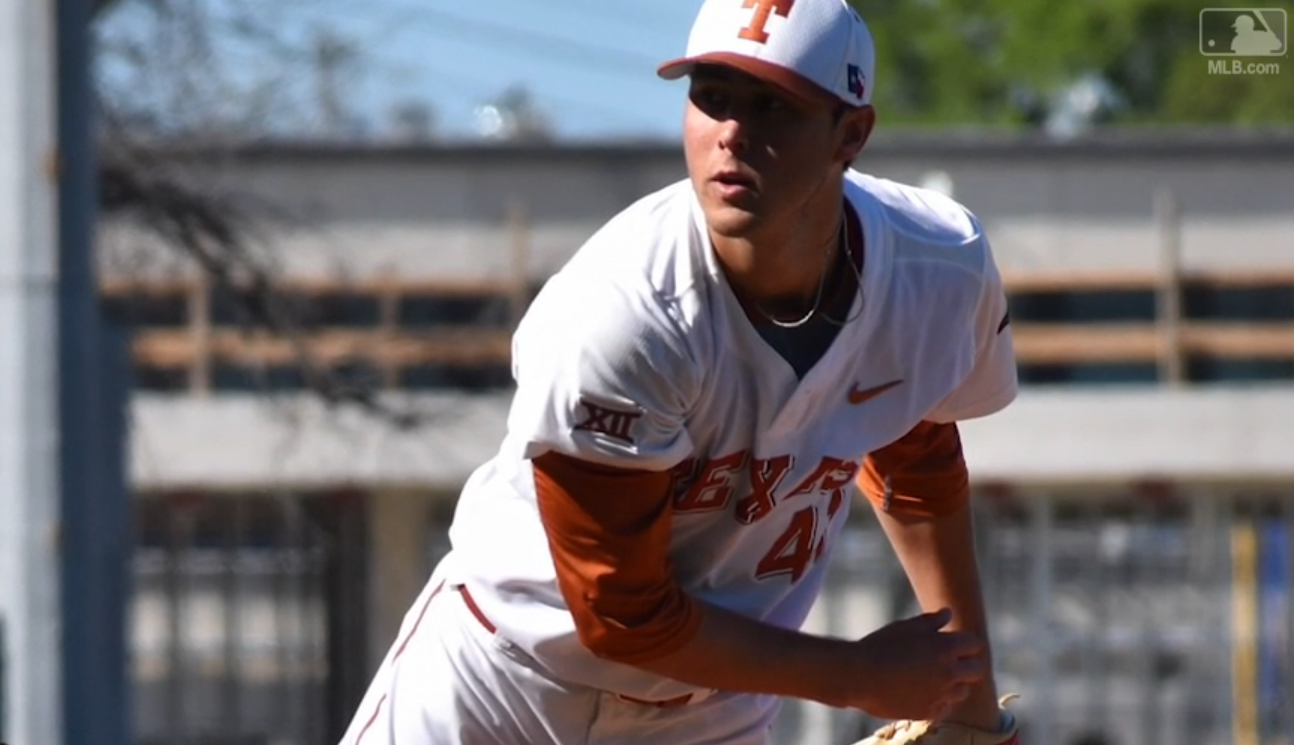The Dodgers went with a college arm in the second round, selecting right-handed pitcher Morgan Cooper out of Texas with their second pick — No. 62 overall — in the 2017 MLB Draft.
Cooper missed 2015 with Tommy John surgery, but as a redshirt junior he posted a 2.32 ERA in 16 games (15 starts), totaling 110 strikeouts and 33 walks in 89.1 innings.
It seems like he was a bit of a signability pick and Cooper lacks elite upside, but there’s a potential solid member of the rotation in there, and the Dodgers will indeed use him as a starter.
Billy Gasparino says the Dodgers consider Morgan Cooper a starter rather than a reliever
— Eric Stephen (@ericstephen) June 13, 2017
Scouting reports paint a picture of a pitcher with mid-rotation upside that could move quickly, but wonder about his endurance and durability. There appeared to be bigger talents still on the board, but if the Dodgers can save a bit of money here to use later in the draft while still coming away with a quality arm, it’s an understandable choice.
Overall, it looks to me like the Dodgers took a bit of a risk on a signability guy here whose main negatives aren’t talent related. Thus, there’s still upside in there and it allows them to be aggressive with talent later in the draft.
——
At his best, Cooper can deal at 92-94 mph and reach 96 with his fastball. He uses his size and an overhand delivery to generate steep downhill plane, helping his heater induce swings and misses as well as groundballs. He still has to prove he can maintain his velocity over a full schedule because it has dipped in the second half of the last two college seasons. While Cooper’s secondary pitches all can grade above-average at times, his changeup is more consistent than his curveball and cutter. He has a sound delivery and arm action, though his control hasn’t been as sharp this year as it has been in the past.
Cooper’s fastball sits 92-93 mph but touches 95-96 at his best and it has some late life. His hard curveball is still not what it was pre-surgery, but it improved throughout the season and his changeup is now average. He’s always been a solid strike thrower who projects to have at least average control. Cooper’s delivery has some stiffness and some effort to it, which concerns evaluators. But his combination of size (6-foot-4), solid stuff and success in the Big 10–he led the league with 96 strikeouts and was third in ERA (2.33) and average against (.200)–should propel him into the third round.
STRENGTHS
Coming back for his junior season was the right thing to do, as Cooper’s stock has soared this spring. He has a stereotypical “big guy from Texas” fastball at 91-96 MPH, and he commands the fastball well. He’s not just a fastball pitcher, able to mix in a curve, cutter/slider, and change-up. The curveball was his best pitch as a freshman but since the injury he’s done good work developing his other two pitches, giving him four quality options. He usually throws strikes and has the complete arsenal needed to start in the majors. His makeup is also considered a strong positive.
WEAKNESSES
Although his mechanics are consistent the heat isn’t exactly “easy” and his radar gun readings sometimes decline as a game progresses, although his full quiver of secondaries helps compensate. His command is occasionally erratic and will need to firm up at the highest levels. The redshirt season makes him an “old” junior at age 22.
OVERALL PROJECTION
Cooper has maintained steady stock as a late second or third round pick all spring but he could go as high as the supplemental round due to his relative lack of leverage and his status as an advanced college arm. He could reach the majors fairly quickly.
Really like Morgan Cooper for Dodgers. Older collegian should sign quickly and was quite productive in tough Big XII. #3 Ceiling.
— David Hood (@davidchood) June 13, 2017
Morgan Cooper low-90s, 88-92 late but mid-90s early in the spring. Multiple viable secondaries (cut, curve), long injury rap sheet.
— Eric Longenhagen (@longenhagen) June 13, 2017
Gasparino on Morgan Cooper: “He has an active fastball, and two breaking balls now that we think are potential plus pitches.”
— Eric Stephen (@truebluela) June 13, 2017
https://twitter.com/TexasBaseball/status/874480572877475842
 Dodgers Digest Los Angeles Dodgers Baseball Blog
Dodgers Digest Los Angeles Dodgers Baseball Blog
